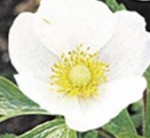 Snowdrop anemone is an herbaceous perennial native to Asia and central and western Europe where it grows in meadows and dry deciduous woodlands. It is a member of the buttercup family, Ranunculace, that also includes columbine, delphinium, and hellebore. The light to medium green leaves are hairy beneath and are divided into three to five toothed segments. The fragrant flowers are 1 ½ to 2 inches across and have five petal-like white sepals surrounding a center of yellow anthers. They are slightly nodding and produced singly on erect stems. Although the primary bloom is in spring, flowers may appear periodically throughout the summer and again in the fall. The fruit is white and wooly. The plants spread by creeping rhizomes and may become a nuisance but are easily removed. Snowdrop anemone is an excellent ground cover for a shade or woodland garden. The genus name, Anemone, may come from the Greek word anemos meaning wind but more likely is a corruption of the Greek loan word referring to the lament for slain Adonis whose blood produced the blood-red Anemone coronaria. The specific epithet, syvestris, comes from the Latin word sylva meaning forest and refers to the habitat of the plant.
Snowdrop anemone is an herbaceous perennial native to Asia and central and western Europe where it grows in meadows and dry deciduous woodlands. It is a member of the buttercup family, Ranunculace, that also includes columbine, delphinium, and hellebore. The light to medium green leaves are hairy beneath and are divided into three to five toothed segments. The fragrant flowers are 1 ½ to 2 inches across and have five petal-like white sepals surrounding a center of yellow anthers. They are slightly nodding and produced singly on erect stems. Although the primary bloom is in spring, flowers may appear periodically throughout the summer and again in the fall. The fruit is white and wooly. The plants spread by creeping rhizomes and may become a nuisance but are easily removed. Snowdrop anemone is an excellent ground cover for a shade or woodland garden. The genus name, Anemone, may come from the Greek word anemos meaning wind but more likely is a corruption of the Greek loan word referring to the lament for slain Adonis whose blood produced the blood-red Anemone coronaria. The specific epithet, syvestris, comes from the Latin word sylva meaning forest and refers to the habitat of the plant.
Type: Herbaceous perennial
Bloom: Fragrant white flowers 1 ½-2 inches across primarily in spring
Size: 1-1 ½’ H x 1’ W
Light: Part shade
Soil: Average, medium moist, well-drained
Hardiness: Zones 4-8
Care: Control unwanted spread
Pests and Diseases: None of significance
Propagation: Division
Companion plants: Spring bulbs, ferns, phlox, common bleeding heart (Dicentra spectabilis), bellflowers (Campanula spp.)
Outstanding Selections:
var. macrantha (aka ‘Grandiflora’; flowers up to 3” across)
‘Flore pleno’ (double flowers)